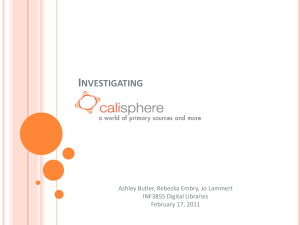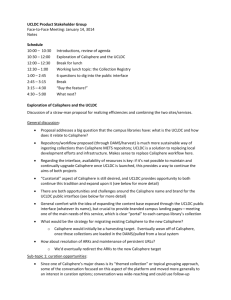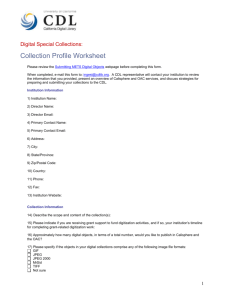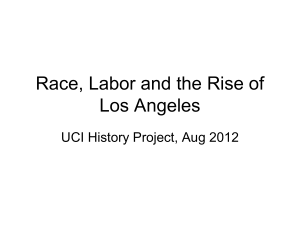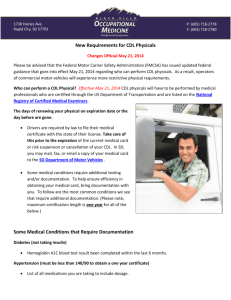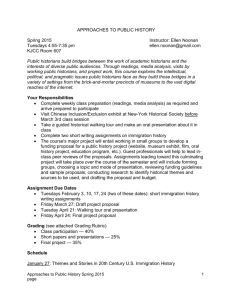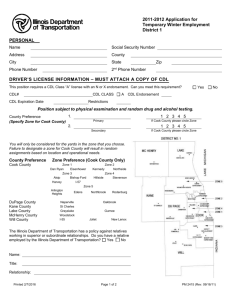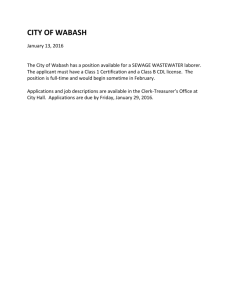Digital collections can be an invaluable addition to any classroom
advertisement
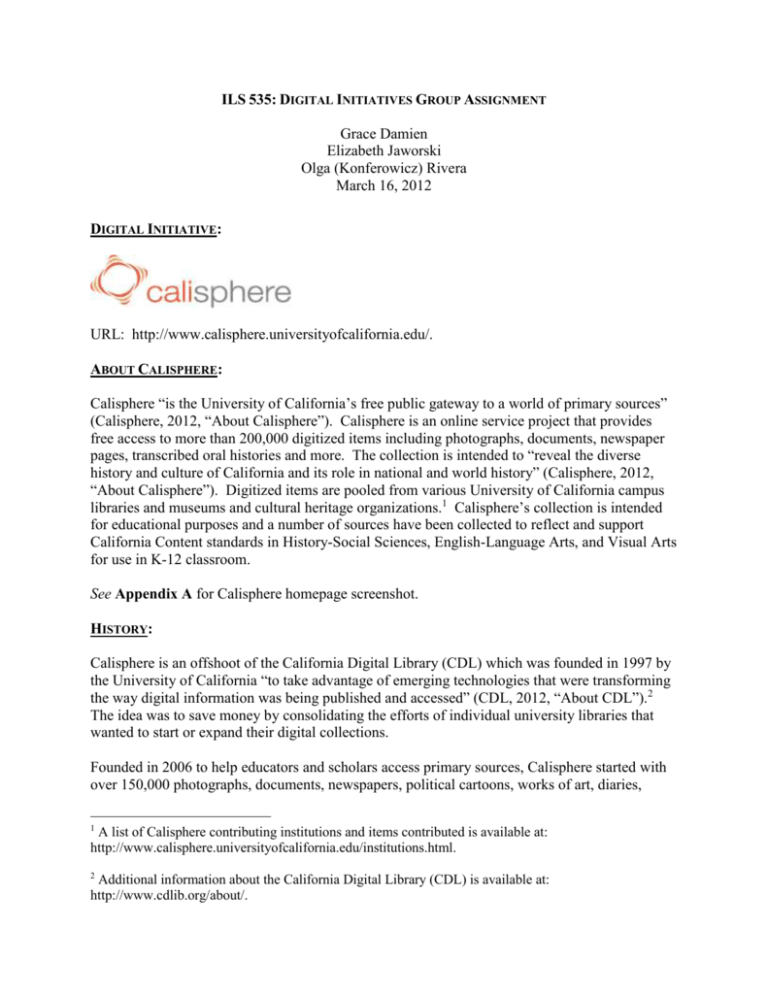
ILS 535: DIGITAL INITIATIVES GROUP ASSIGNMENT Grace Damien Elizabeth Jaworski Olga (Konferowicz) Rivera March 16, 2012 DIGITAL INITIATIVE: URL: http://www.calisphere.universityofcalifornia.edu/. ABOUT CALISPHERE: Calisphere “is the University of California’s free public gateway to a world of primary sources” (Calisphere, 2012, “About Calisphere”). Calisphere is an online service project that provides free access to more than 200,000 digitized items including photographs, documents, newspaper pages, transcribed oral histories and more. The collection is intended to “reveal the diverse history and culture of California and its role in national and world history” (Calisphere, 2012, “About Calisphere”). Digitized items are pooled from various University of California campus libraries and museums and cultural heritage organizations.1 Calisphere’s collection is intended for educational purposes and a number of sources have been collected to reflect and support California Content standards in History-Social Sciences, English-Language Arts, and Visual Arts for use in K-12 classroom. See Appendix A for Calisphere homepage screenshot. HISTORY: Calisphere is an offshoot of the California Digital Library (CDL) which was founded in 1997 by the University of California “to take advantage of emerging technologies that were transforming the way digital information was being published and accessed” (CDL, 2012, “About CDL”).2 The idea was to save money by consolidating the efforts of individual university libraries that wanted to start or expand their digital collections. Founded in 2006 to help educators and scholars access primary sources, Calisphere started with over 150,000 photographs, documents, newspapers, political cartoons, works of art, diaries, 1 A list of Calisphere contributing institutions and items contributed is available at: http://www.calisphere.universityofcalifornia.edu/institutions.html. 2 Additional information about the California Digital Library (CDL) is available at: http://www.cdlib.org/about/. ILS 535: Digital Initiatives Group Assignment transcribed oral histories, advertisements, and other cultural artifacts. Although many of these items were already digitized, they were housed at more than 300 UC libraries across the State of California. This made research difficult, and did not facilitate resource sharing. According to John King, vice provost for academic information, the time and money invested to create Calisphere made sense: “These new systems will bring a transformation in scholarly productivity and quality. Scholars will be able to find virtually everything available on their topic easily and quickly. Public domain materials will be available instantly, while copyrighted materials will be readily accessible through the library’s conventional processes” (Duke, 2006, p. 10). OBJECTIVES: Calisphere is a public service project of the California Digital Library (CDL). Through the use of technology and innovation, the CDL supports the assembly and creative use of scholarship for the UC libraries and the communities they serve. Through Calisphere, primary sources have been collected into sets that support the California Content Standards in History-Social Sciences, English-Language Arts, and Visual Arts for use in K-12 classrooms. These collections of primary sources were designed for teachers and include information on teaching and learning with primary sources, sample lesson plans, primary source analysis sheets, and more. Calisphere also provides a single point of access to more than 500 UC websites “that explore the diverse interests of the University of California campuses” (Calisphere, 2012, “About Calisphere”). PRODUCERS: Calisphere is powered by the California Digital Library (CDL). Calisphere is a joint effort of the individual university libraries and the CDL. CONTENT: Calisphere is a free website that offers educators, students, and the public access to more than 200,000 primary sources such as photographs, documents, newspapers, political cartoons, works of art, diaries, transcribed oral histories, and other cultural artifacts. Calisphere’s content is drawn from the digital content in the Online Archive of California (OAC)3. However, OAC and Calisphere serve two different user needs. For research-oriented users who want to go beyond what is available online and locate the actual, physical item, OAC is the best starting point. For users whose primary interest is to view digitized images and documents, Calisphere is the place to explore online content. In addition, Calisphere provides K12 educators with a subset of content organized and aligned with California Content Standards. 3 Additional information about Online Archive of California (OAC) is available at: http://www.cdlib.org/services/dsc/oac/. 2 ILS 535: Digital Initiatives Group Assignment Calisphere has collected primary sources into “sets” that support the California Content Standards and make it easy for teachers to find the materials they need: (1) Themed Collections: primary source materials organized into historical eras from the 1780s to the 1970s; (2) California Cultures: photographs and documents related to the stories, struggles and contributions of the four major ethnic groups in California (African Americans, Asian Americans, Hispanic Americans, and Native Americans); (3) Japanese American Relocation Digital Archives (JARDA): personal and official images and documents showing the story of the Japanese American internment during World War II; (4) Local History Mapped: five maps overlayed with hundreds of historical photographs which show the diverse history and geography of California. In addition, Calisphere provides access to: (5) 500 UC websites that reflect the diverse interests and scholarship of the ten University of California campuses. Calisphere users can keyword search collection sets, browse an alphabetical list of terms selected from the California Content Standards (Browse A–Z), and explore UC websites. Examples of Calisphere’s Themed Collections 1780-1880: California in Transition Topics: Early California Exploration and Settlement California Missions Californio Society Rich Resources Everyday Life Several social, political, and economic transitions marked the conquest and cultural exchange of California's early history. Native American communities were transformed as a result of European exploration and settlement in the late 18th century. Spain constructed missions and military presidios in Alta California to increase Spanish settlement in the new colony and encourage religious conversion among Native Americans. The mission structures remained long after the collapse of Spanish authority. Following Mexico's independence from Spain in 1821, vast land grants helped elite Californio society flourish until the 1880s. Today, the state's wealth continues to be defined through the utilization of its rich resources and its immense natural and human potential. 3 ILS 535: Digital Initiatives Group Assignment 1848-1865: The Gold Rush Era Topics: Murder and Mayhem Disasters Everyday Life and People Environmental Impact Growth of Cities Diversity in the Changing State The few short years of the Gold Rush changed California's population and environment dramatically. Ethnic diversity grew as people from all over the world poured into the state, ignoring numerous dangers and the ever-present risk of earthquakes to follow their dreams of striking gold. This sudden influx, and the gold mining industry in general, had a significant impact on the environment and contributed to the rapid growth of cities throughout the state. The state's legal infrastructure lagged behind this growth, however, and the lawless atmosphere of the gold mining communities led to a growing problem of murder and mayhem. Law-abiding citizens began to see the need to strengthen existing legal and judicial institutions to ensure a more peaceful approach to everyday life. California Cultures California Cultures provides access to digitized materials on California’s multicultural history. Selected primary source sets tell the stories, struggles, and contributions of the four major ethnic groups in California that have been historically underrepresented by digitized primary source materials (African Americans, Asian Americans, Hispanic Americans, and Native Americans). Japanese American Relocation Digital Archives (JARDA) JARDA provides access to digitized materials such as personal and official photographs, letters and diaries, transcribed oral histories, and art which show: the faces of the men, women, and children who were incarcerated; prewar neighborhoods and wartime camps; and, letters, diaries, art and other writing by internees. JARDA further provides background and historical context information, and teacher-created lesson plans. Examples of University of California Created Websites Explore more than 500 specially selected websites created by UC faculty, librarians, and researchers and gain access to thousands of photographs, interviews, sound recordings, maps, historical documents, current articles and research, videos, sheet music, electronic books, and more. Many of UC's museums, concert halls, art galleries, medical centers, botanical gardens, observatories, and marine centers are represented in this collection. UC Berkeley: Visit the Museum of Paleontology to learn all about dinosaurs, explore more than 700 photos of Africa from the California Academy of Sciences, and discover the colorful world of auroras. 4 ILS 535: Digital Initiatives Group Assignment UC Davis: Discover classic American food from antiquity to the space age, dig into the life and times of earthworms, and read the full text of works by nearly 60 British and Irish women Romantic poets. USERS: Anyone can access Calisphere and its sources for free. Calisphere’s sources can be used in the classroom for private study, research, and teaching as long as the use is in accordance with the terms of fair use.4 Calisphere makes it the responsibility of the user to verify the copyright status of any specific item. However, whenever possible, the CDL provides available information to the user about restrictions contained within the metadata associated with sources. BENEFITS: Digital collections can be an invaluable addition to any classroom. They allow students to see items that would otherwise be unavailable to them. The photographs, letters and other primary sources available through Calisphere enhance learning and enrich students’ knowledge. Calisphere is an initiative that gives students in California—and the public in general—access to primary sources related to California’s history. FUNDING: Funding and support for Calisphere comes primarily from grants and partnerships associated with the University of California.5 The California Digital Library (CDL) also collaborates with various state, national and international partners. These partners aid the CDL in: collection development and management; digital preservation; digital special collections; publishing; and university and system-wide initiatives. Calisphere is also supported by contributions of digitized primary sources from a variety of institutions (see fn1 for a list of contributing institutions). FUTURE: The California Digital Library (CDL) “exists to support the University of California community’s pursuit of scholarship and to extend the University’s public service mission” (Calisphere, 2012, “Mission, Vision, and Values”).6 The CDL’s vision is “to elevate the digital library for UC so that it becomes expansively global and deeply local.” 4 Terms and conditions of fair use are available at: http://www.calisphere.universityofcalifornia.edu/copyright-cs.html. 5 A list of Calisphere’s partners is available at: http://www.cdlib.org/about/grants.html. 6 Mission, Vision and Values, and Strategic Planning, Goals and Objectives available at: http://www.cdlib.org/about/mission.html. 5 ILS 535: Digital Initiatives Group Assignment The CDL posts PDF documents stating its current goals and objectives, as well as completed objectives and recommendations (see fn6). The four primary Goals and Objectives for 2011– 2012 carry forward many of themes from the previous year and “encompass new significant areas of emphasis that reflect the University’s ongoing budget challenges, changes in the academic environment and scholarly practice, and key initiatives of the campus libraries” (CDL, Goals and Objectives 2011–2012). Goals and Objectives 2011–2012: (1) Support next generation initiatives and recommendations of the systemwide library and scholarly information advisory committee library planning task force. (2) Support the UC scholarly research and teaching life cycle. (3) Provide leadership in digital library development and service adoption. (4) Diversify funding sources and extend efficiencies. 6 ILS 535: Digital Initiatives Group Assignment APPENDIX A: CALISPHERE HOMEPAGE 7 ILS 535: Digital Initiatives Group Assignment References Duke , J. (Ed.) (2006). UC launches Calisphere website. Advanced Technology Library, 35(10), 10. 8
